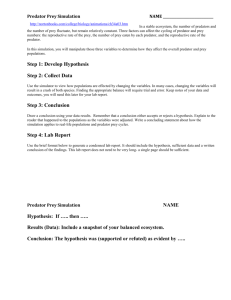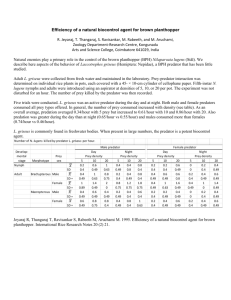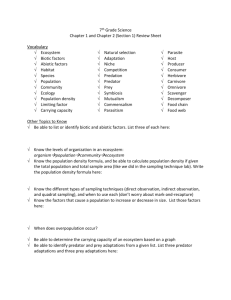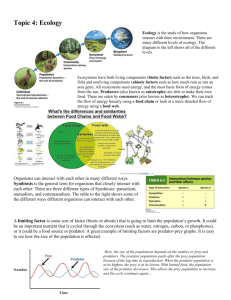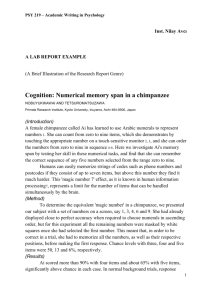Infusion of Literacy into the Science Curriculum Book Information
advertisement
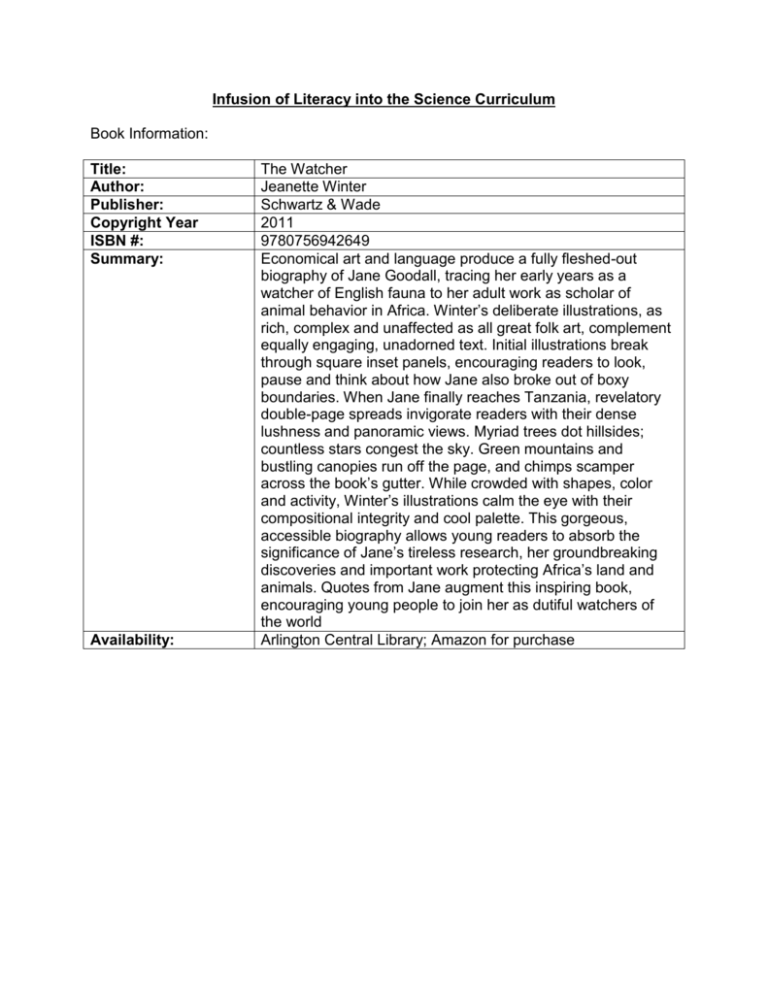
Infusion of Literacy into the Science Curriculum Book Information: Title: Author: Publisher: Copyright Year ISBN #: Summary: Availability: The Watcher Jeanette Winter Schwartz & Wade 2011 9780756942649 Economical art and language produce a fully fleshed-out biography of Jane Goodall, tracing her early years as a watcher of English fauna to her adult work as scholar of animal behavior in Africa. Winter’s deliberate illustrations, as rich, complex and unaffected as all great folk art, complement equally engaging, unadorned text. Initial illustrations break through square inset panels, encouraging readers to look, pause and think about how Jane also broke out of boxy boundaries. When Jane finally reaches Tanzania, revelatory double-page spreads invigorate readers with their dense lushness and panoramic views. Myriad trees dot hillsides; countless stars congest the sky. Green mountains and bustling canopies run off the page, and chimps scamper across the book’s gutter. While crowded with shapes, color and activity, Winter’s illustrations calm the eye with their compositional integrity and cool palette. This gorgeous, accessible biography allows young readers to absorb the significance of Jane’s tireless research, her groundbreaking discoveries and important work protecting Africa’s land and animals. Quotes from Jane augment this inspiring book, encouraging young people to join her as dutiful watchers of the world Arlington Central Library; Amazon for purchase How can the book content be infused into the science curriculum? Grade Level Strands Kindergarten K-3 Scientific Investigation, Reasoning and Logic, Life Processes, Living Systems, Earth Patterns, Cycles and Change, Interrelationships in Earth/Space Systems K.7 Life Processes The student will investigate and understand basic needs and life processes of plants and animals. Key concepts include a) animals need adequate food, water, shelter, air, and space to survive; b) plants need nutrients, water, air, light, and a place to grow to survive; c) plants and animals change as they grow, have varied life cycles, and eventually die; and d) offspring of plants and animals are similar but not identical to their parents or to one another. Earth Patterns, Cycles, and Change K.9 The student will investigate and understand that there are simple repeating patterns in his/her daily life. Key concepts include c) animal and plant growth. Grade 1 Scientific Investigation, Reasoning, and Logic 1.1 The student will demonstrate an understanding of scientific reasoning, logic, and the nature of science by planning and conducting investigations in which c) objects or events are classified and arranged according to characteristics or properties; f) inferences are made and conclusions are drawn about familiar objects and events; g) a question is developed from one or more observations; h) predictions are made based on patterns of observations; i) observations and data are recorded, analyzed, and communicated orally and with simple graphs, pictures, written statements, and numbers; and Life Processes 1.5 The student will investigate and understand that animals, including humans, have basic needs and certain distinguishing characteristics. Key concepts include a) basic needs include adequate air, food, water, shelter, and space (habitat); b) animals, including humans, have many different physical characteristics; and c) animals can be classified according to a variety of characteristics. Earth Patterns, Cycles, and Change 1.7 Grade 2 The student will investigate and understand weather and seasonal changes. Key concepts include a) changes in temperature, light, and precipitation affect plants and animals, including humans; Life Processes 2.4 The student will investigate and understand that plants and animals undergo a series of orderly changes as they mature and grow. Key concepts include a) animal life cycles; Living Systems 2.5 The student will investigate and understand that living things are part of a system. Key concepts include a) living organisms are interdependent with their living and nonliving surroundings; b) an animal’s habitat includes adequate food, water, shelter or cover, and space; c) habitats change over time due to many influences; and Earth Patterns, Cycles, and Change Grade 3 2.7 The student will investigate and understand that weather and seasonal changes affect plants, animals, and their surroundings. Key concepts include Scientific Investigation, Reasoning, and Logic 3.1 The student will demonstrate an understanding of scientific reasoning, logic, and the nature of science by planning and conducting investigations in which a) observations are made and are repeated to ensure accuracy; b) predictions are formulated using a variety of sources of information; d) natural events are sequenced chronologically; g) questions are developed to formulate hypotheses; h) data are gathered, charted, graphed, and analyzed; i) unexpected or unusual quantitative data are recognized; j) inferences are made and conclusions are drawn; k) data are communicated; l) models are designed and built; and m) current applications are used to reinforce science concepts. Life Processes 3.4 The student will investigate and understand that adaptations allow animals to satisfy life needs and respond to the environment. Key concepts include a) behavioral adaptations; and b) physical adaptations. Living Systems 3.5 The student will investigate and understand relationships among organisms in aquatic and terrestrial food chains. Key concepts include a) producer, consumer, decomposer; b) herbivore, carnivore, omnivore; and c) predator and prey. 3.6 The student will investigate and understand that ecosystems support a diversity of plants and animals that share limited resources. Key concepts include b) terrestrial ecosystems; c) populations and communities; and d) the human role in conserving limited resources. Earth Patterns, Cycles, and Change 3.8 The student will investigate and understand basic patterns and cycles occurring in nature. Key concepts include b) animal life cycles; and Earth Resources 3.10 The student will investigate and understand that natural events and human influences can affect the survival of species. Key concepts include a) the interdependency of plants and animals; Grade 4 Grade 5 Sample Activities: Grade 1 See 2 attached worksheets. Grade K "What Does the Chimp Eat?" Topic: The students will be learning about how the Chimpanzee acquires energy and the resources it needs to do so. In this, they will also be learning the difference between predator and prey, and plant eating, meat eating, and all eating animals. Rationale: It is important for the children to acknowledge the chimp as a component in the food chain of life. They need to be able to make the distinction between those that are weaker and those that are stronger and relate it to the concept of survival. It is also important for the children to be able to compare and contrast the diet of the chimp with that of their own in order to recognize the strong similarity of human and ape. Prior Knowledge: The students are aware of the Chimpanzee’s environment. They know of the different plants and animals that reside in this environment. Therefore, they might be able to predict what the chimp eats and how it goes about getting it. Objectives: The students will be able to recognize that all animals need food for survival. They will be able to identify the foods of the chimp and the processes in which the chimp endures to acquire them. The students will be able to relate these processes to the processes of human beings. They will be able to perceive the chimp as an intelligent and strategic creature. The students will be able to differentiate from predator and prey. The students will be able to categorize the chimpanzee as an omnivore. Hook: I will ask the children, "Why do we need food?" I will emphasize the word "energy". I will then ask, "What are some of the foods we eat?" "Do you think a Chimpanzee eats the same foods as we do?" "What kind of foods do you think they eat?" I will have them sing a song I wrote explaining what chimps like to eat. See song. I will then make a formal list consisting of fruits, berries, flowers, leaves, grass, bark, nuts, fig, insects (termites), small pigs, and antelopes. Lesson Narrative: 1. I will ask the children, "How are some of the ways we get food?" "Do you think chimps get food the same way we do?" "How do you think chimps might get food?" I will list the correct responses and tell them that they spend much time in trees searching for food and just like us, squeeze fruit to see if its rip enough to eat. I will tell them they use rocks like hammers to break open nuts and pods. I will tell them that they drink by cupping water in their hands from lakes and rivers and by using leaves to scoop up rainwater in the holes of trees. I will then read them an excerpt from The Watcher. 2. I will tell the children that the pig and the antelope are called the chimp’s prey, or food. I will have them repeat the word prey. I will then say, "When the chimp hunts these animals it is called a predator, or hunter. I will have them repeat predator. I will say, "So, here the chimp is the predator and the pig and antelope are the prey. Do you think anything tries to eat the chimp?" I will introduce the leopard. I will ask, "So when the leopard hunts the chimp, is the chimp the predator or the prey?" I will tell them that now the lion is the predator, or hunter, and the chimp now the prey, or food. 3. I will tell the children that there are three groups of eaters. Animals that eat plants called, herbivores, animals that eat other animals called, carnivores, and animals that eat both plants and animals called, omnivores. I will write these down on the board with there descriptions. I will then ask, "Which kind of eater do you think the chimp is?" (Omnivore) Closure: I will have the children draw a picture of the chimp and any other animal that we discussed today. I will have them label the chimp the predator or the prey according to the picture. I will also have them label the other animal accordingly. Individualization: Those who need assistance in spelling can copy down the new words I put on the board and use them in a sentence. For the drawing exercise, those at a higher level can choose to write more about their picture, while others may just label their animals as "predator" and "prey". Materials: poster board, drawing paper Imagination: The students will use their imagination as they think of the way chimps get their food. They will imagine how the chimps attack their prey and are attacked by predators. They will envision a scene as they draw their predator and prey. Education for Democracy: The students will be able to witness a hierarchy of power within the tropical forest food chain. They will see how the chimps share food in hopes that they are shared with in the future, just as people. The students will need to cooperate and sing the song in unison to make it powerful.

